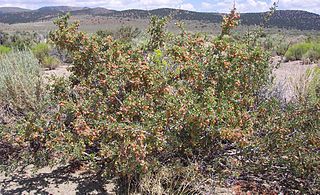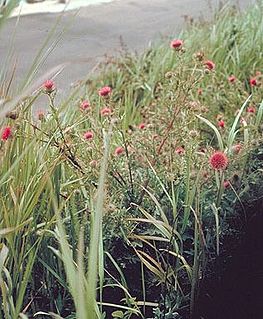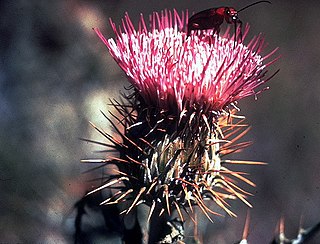
Prunus andersonii is a species of shrub in the rose family, part of the same genus as the peach, cherry, and almond. Its common names include desert peach and desert almond. It is native to eastern California and western Nevada, where it grows in forests and scrub in desert and mountains. It was named after Charles Lewis Anderson by Asa Gray.

Cirsium quercetorum is a species of thistle endemic to coastal California, its common names include brownie thistle and Alameda thistle.

Cirsium arizonicum, the Arizona thistle, is a North American species of thistle in the sunflower family, native to the southwestern United States and northwestern Mexico. It has been found in Arizona, southeastern California, New Mexico, Nevada, Colorado, Utah, Sonora, and northwestern Chihuahua.

Cirsium neomexicanum is a North American species of thistle known by the common names New Mexico thistle, powderpuff thistle, lavender thistle, foss thistle and desert thistle.

Cirsium occidentale, with the common name cobweb thistle or cobwebby thistle, is a North American species of thistle in the sunflower family.

Lycium andersonii is a species of flowering plant in the nightshade family, Solanaceae. Its common names include water-jacket, redberry desert-thorn, Anderson thornbush, Anderson's desert thorn, Anderson boxthorn, Anderson lycium, Anderson wolfberry, and squawberry.

Astragalus andersonii is a species of milkvetch known by the common name Anderson's milkvetch. It is native to eastern California and western Nevada, where it is found in the plateaus at the foot of the Sierra Nevada, including the Modoc Plateau. It was named after Charles Lewis Anderson by Asa Gray.

Cirsium andrewsii is an uncommon species of thistle known by the common name Franciscan thistle. It is endemic to California, where it is known from the coastline of the San Francisco Bay Area from Marin to San Mateo Counties. There are also reports of isolated populations in the Klamath Mountains and in the Sierra Nevada.
Cirsium ciliolatum is a species of thistle known by the common name Ashland thistle. It is endemic to the Klamath Mountains, where it is known from only a few occurrences in Jackson and Josephine Counties in Oregon, as well as neighboring Humboldt and Siskiyou Counties in California. It is related to Cirsium undulatum and may be more accurately described as a variety of that species.
Cirsium crassicaule is a species of thistle known by the common name slough thistle. It is endemic to the San Joaquin Valley of California, where it is known primarily from freshwater wetlands. It has been found in only a few locations in Kern, Kings, and San Joaquin Counties.

Cirsium cymosum is a North American species of thistle known by the common name peregrine thistle. It is native to the western United States, where it has been found in California, Oregon, Nevada, Utah, Idaho, Wyoming, and Montana.

Cirsium douglasii is a species of thistle known by the common names Douglas' thistle and California swamp thistle.

Cirsium hydrophilum is a species of thistle which is endemic to California, where it is found only in the San Francisco Bay Area and the Sacramento-San Joaquin River Delta. This native thistle grows in wet boggy habitats.

Cirsium loncholepis is a rare species of thistle known by the common name La Graciosa thistle. It is endemic to California, where it is known from about 15 remaining occurrences in wetlands where southwestern San Luis Obispo County borders northwestern Santa Barbara County. It grows in coastal scrub and sand dunes, marshes, and moist grasslands in the watersheds of local rivers, including the Santa Maria River. It is a federally listed endangered species.

Cirsium mohavense is a species of thistle known by the common names virgin thistle and Mojave thistle. It is native to the southwestern United States, where it grows in moist areas in otherwise dry habitat, such as desert springs. It is most common in the Mojave Desert, found also in the southern Great Basin and other nearby regions of California, Nevada, western Arizona, and southwestern Utah.

Cirsium ochrocentrum is a species of thistle known by the common name yellowspine thistle. It is native to the Great Plains of the Central United States and to the desert regions of the western United States and northern Mexico. Its range extends from eastern Oregon east to the Black Hills of South Dakota, south as far as the Mexican State of Durango.

Cirsium scariosum is a species of thistle known by the common names meadow thistle, elk thistle and dwarf thistle. It is native to much of western North America from Alberta and British Columbia south to Baja California. There are also isolated populations on the Canadian Atlantic Coast, on the Mingan Archipelago in Québec.

Cirsium undulatum is a species of thistle known by the common names wavyleaf thistle and gray thistle. It is native to much of central and western North America from British Columbia east to Manitoba and south as far as the State of Durango in Mexico. It has also been found outside of its native range as an introduced species.
Trifolium andersonii is a species of clover known by the common names fiveleaf clover and Anderson's clover. It is native to the western United States, particularly the Great Basin and adjacent high mountain ranges, including the Sierra Nevada. It was named after Charles Lewis Anderson by Asa Gray.

Charles Lewis Anderson was an American medical doctor who, in addition to the practice of medicine, made important contributions to fields of natural history, especially botany. Educated in Indiana, he spent most of his professional life in the upper Midwest and West. Many plants collected by him were subsequently named in his honor. He wrote about local natural history, and actively engaged in public service in places where he resided.

















